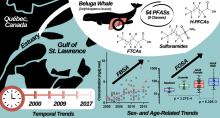| Title | Determination and occurrence of retinoic acids and their 4-oxo metabolites in Liaodong Bay, China, and its adjacent rivers. |
| Publication Type | Journal Article |
| Year of Publication | 2010 |
| Authors | Wu, X, Hu, J, Jia, A, Peng, H, Wu, S, Dong, Z |
| Journal | Environ Toxicol Chem |
| Volume | 29 |
| Issue | 11 |
| Pagination | 2491-7 |
| Date Published | 2010 Nov |
| ISSN | 1552-8618 |
| Keywords | China, Chromatography, High Pressure Liquid, Rivers, Spectrometry, Mass, Electrospray Ionization, Stereoisomerism, Tretinoin, Water Pollutants, Chemical |
| Abstract | Retinoic acids (RAs) and their metabolites play an important role in abnormal morphological development and are speculated to be a possible cause for the increased rates of deformities in wild frog populations. In the current study, a method using ultra-performance liquid chromatography-electrospray ionization tandem mass spectrometry was developed for simultaneously analyzing all-trans-RA (at-RA), 13-cis-RA (13c-RA), 9-cis-RA (9c-RA), and their 4-oxo metabolites, all-trans-4-oxo-RA (at-4-oxo-RA), 13-cis-4-oxo-RA (13c-4-oxo-RA), and 9-cis-4-oxo-RA (9c-4-oxo-RA) in wastewaters and surface waters. Method detection limits were matrix dependent, ranging from 0.02 to 0.37 ng/L. The method was used to investigate the occurrence of RAs and 4-oxo-RAs in Liaodong Bay and its adjacent rivers. Of these six retinoids, at-RA, 13c-RA, at-4-oxo-RA, and 13c-4-oxo-RA were detected in river waters at detection frequencies of 100%, 92%, 48.6%, and 21.6%, and concentrations of 0.05 to 1.23 ng/L, less than 0.03 to 0.41 ng/L, less than 0.02 to 1.00 ng/L, and less than 0.06 to 0.81 ng/L, respectively. Retinoic acids were detected for the first time in the aquatic environment and were found to be more persistent than 4-oxo-RAs. The hazard quotient for mortality of frog embryos caused by induction by retinoids detected in the current study was then estimated, and the value was calculated to be 0.09. No retinoid was detected in seawaters. |
| DOI | 10.1002/etc.322 |
| Alternate Journal | Environ. Toxicol. Chem. |
| PubMed ID | 20886503 |
Environmental Chemical Biology

